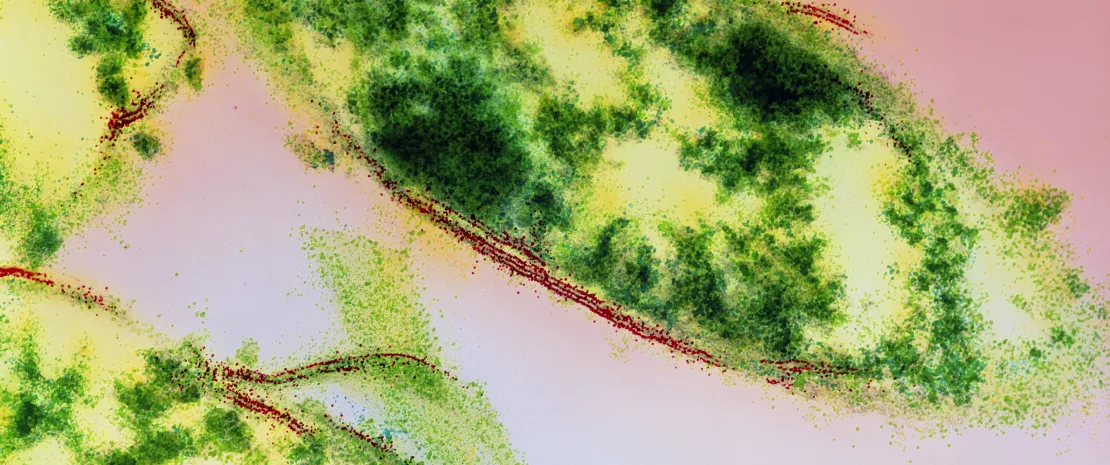From the mouth to the colon: tracing the route of Fusobacterium
A surprising new study reveals that Fusobacterium nucleatum, typically an oral bacterium, migrates to the colon and dominates colorectal cancer tumors. Researchers found that a distinct clade, Fna C2, not only thrives in these tumors but also actively promotes cancer growth.
Sources
This article is based on scientific information

About this article
Author
New study has identified a specific clade of the bacterium (sidenote: Fusobacterium nucleatum Fusobacterium nucleatum is a Gram-negative, anaerobic bacterium commonly found in the human oral cavity. It plays a role in periodontal diseases and has been associated with various infections and inflammatory conditions. Fusobacterium nucleatum is notable for its ability to adhere to and invade host tissues, facilitating interactions with other microorganisms and host cells. ) (Fn) that dominates the (sidenote: Colorectal cancer Colorectal cancer is a type of cancer that begins in the colon (large intestine) or the rectum. It typically starts as small, benign clumps of cells called polyps that form on the inner lining of the colon or rectum. Over time, some of these polyps can become cancerous. ) (CRC) niche, revealing significant insights into the bacterium's role in cancer progression. 1 This groundbreaking study, led by Fred Hutchinson Cancer Center researchers, uncovers genetic and functional distinctions in Fn strains associated with CRC, highlighting potential targets for therapeutic interventions.
Identifying the culprit
The research team collected and sequenced genomes from 135 Fn strains, including 80 from healthy oral cavities and 55 from CRC tumors. Using advanced genomic techniques, they performed a pangenomic analysis, which identified 483 genetic factors enriched in CRC-associated strains. The findings revealed that the Fn subspecies animalis (Fna), previously considered a single subspecies, is actually composed of two distinct clades: Fna C1 and Fna C2. Among these, only Fna C2 was found to dominate the CRC tumor niche, suggesting a unique role in cancer development.
Fusobacterium nucleatum was detected in 29.2% of stool samples from patients with CRC and 4.8% of stool samples from healthy individuals.
Genetic and functional Insights
Further analysis showed that Fna C2 possesses 195 genetic factors associated with increased metabolic potential and gastrointestinal colonization, distinguishing it from Fna C1. This clade-specific genetic repertoire includes genes that enhance the bacterium's ability to invade host tissues and evade immune responses. The study also demonstrated that Fna C2-treated mice developed significantly more intestinal adenomas compared to those treated with Fna C1 or control groups. This suggests that Fna C2 not only colonizes CRC tumors but also actively promotes tumor growth.
Implications for treatment
These findings have profound implications for understanding the microbiome's role in CRC and developing targeted treatments. The study highlights the potential of focusing on Fna C2 for therapeutic interventions. For instance, identifying and targeting the specific metabolic pathways and virulence factors unique to Fna C2 could lead to new strategies for preventing or treating CRC. Additionally, the research underscores the importance of considering bacterial clades rather than species alone in microbiome studies, as significant differences can exist within subspecies.
The discovery of the distinct Fna C2 clade and its association with CRC marks a significant advancement in microbiome research and cancer biology. By delineating the genetic factors that enable Fna C2 to thrive in the CRC environment, this study opens new avenues for targeted therapies and improved patient outcomes.
As the role of the microbiome in cancer becomes increasingly evident, focusing on specific bacterial clades may prove crucial in developing effective treatments. This research sets the stage for further exploration into the intricate relationship between our microbiota and cancer, potentially transforming our approach to cancer therapy.














